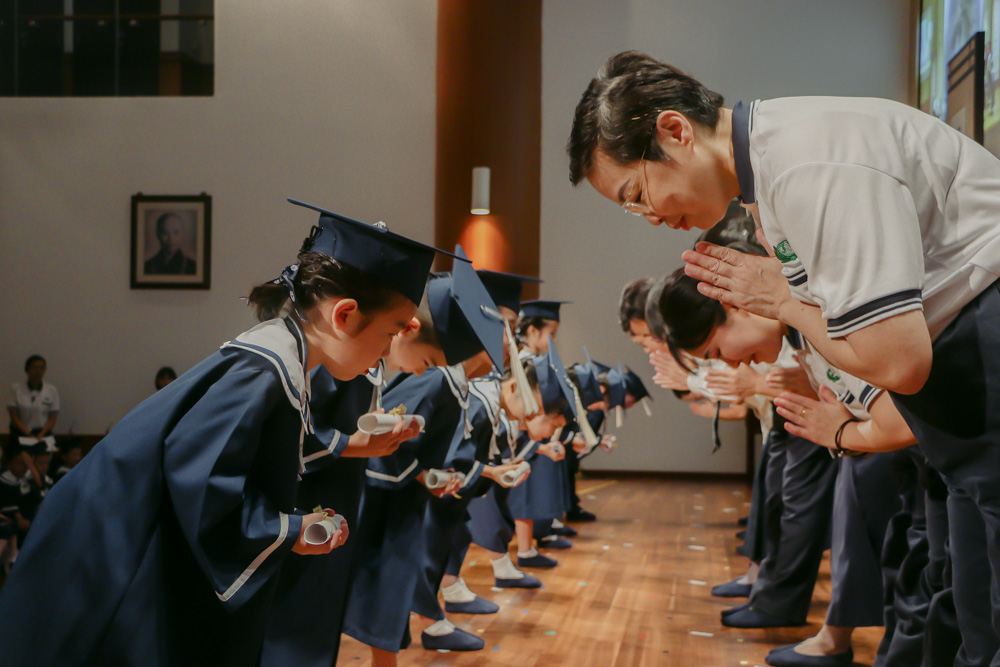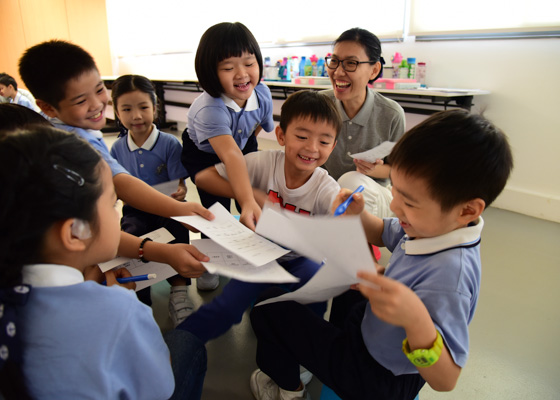Disclaimer: All activities depicted in this article were conducted in compliance with the COVID-19 rules and regulations at that given time.
 A Kidz Hideout participant seen here presenting his artwork created during the art therapy activity to teachers and family members. (Photo by Willy Ang)
A Kidz Hideout participant seen here presenting his artwork created during the art therapy activity to teachers and family members. (Photo by Willy Ang)
During the interview, the burgeoning confidence in 11-year-old Kidz Hideout participant Muhammad Qadri Bin Muhammad Rizal was palpable. For every question put out to him, he was able to take it on nonchalantly, elaborating in great detail with the demeanor of a child far beyond his age. But according to Qadri’s mother, Ms Mazlizah Binte Selasa, this would have been improbable just months ago.
“He used to be quite shy and not comfortable with voicing out his feelings. But after coming here, I have seen great improvements. He is more verbal and confident now, and no longer shy in voicing his opinions,” explained Ms Mazlizah.
Since the start of the year, a group of 20 North View Primary Four and Five students have been diligently making their way to Tzu Chi Humanistic Youth Centre (HYC) to participate in Kidz Hideout, an after-school befriending and homework support programme for primary school students. Curated and organised by the HYC team and its partners, the enrichment programme features many activities specifically targeted at improving the students’ overall well-being.
Art therapy has been an integral part of Kidz Hideout and the eight-session-long activity, where students got to express their inner feelings through different mediums of art, had been one of the key driving forces behind Qadri’s change.
“Sometimes, kids have difficulty finding the words to express themselves, and art has opened up more avenues for them to be more expressive. In the past, when he needed help in school, he would rather keep quiet. Now, he is raising up hands, asking for help from teachers and also voicing out if he feels that something is not right,” added Ms Mazlizah.
Qadri has come a long way since the shy, unassuming boy he was at the start of the year. Over time, he found himself thoroughly enjoying the art therapy lessons and felt that it had contributed to his own behavioural improvements.
“I have changed a lot. I used to be more troublesome, running around and annoying my teacher. Now, I will just focus on my own artwork during art therapy lessons,” he remarked.
“I feel good that I can express what I cannot in real life through my paintings. If I’m feeling mad, I can paint in red. If I’m feeling sad, I can use blue. What I’m feeling on that day, I will try to express through painting.”
 Kidz Hideout participant Muhammad Qadri Bin Muhammad Rizal (left) seen here embracing his mother, Ms Mazlizah Binte Selasa (right). (Screenshot by Pan Zaixiang)
Kidz Hideout participant Muhammad Qadri Bin Muhammad Rizal (left) seen here embracing his mother, Ms Mazlizah Binte Selasa (right). (Screenshot by Pan Zaixiang)
Slowly Warming Up to Art Therapy
Given that the main purpose of art therapy was to serve as an emotional outlet for the students’ inner feelings, the focus was not on the aesthetics of their artworks. Nevertheless, beautiful products with a deeper meaning were still produced at the end and the Tzu Chi Kidz Hideout team decided to feature them through the Kidz Creatorz Exhibition, where the students’ teachers and parents were invited to HYC for a showcase.
According to HYC Youth Outreach Officer, Ms Sharifah Faizah, organising the exhibition had been a boost to the students as it provided them with a goal to work towards. The students had also started gravitating more towards art therapy as the weeks went by.
“Art therapy is actually one of the first few enrichment activities that we engaged. In the very beginning, we had a lot of resistance from the kids. Some of them would say that they don’t like art. We were also worried that the more rambunctious kids wouldn’t participate. The first two sessions were quite a handful, the kids refuse to sit down and were running all over the place,” she recalled.
“But after the art therapists took out the painting materials in the third session, all the kids started to participate. Even the most active kid, who would usually refuse to stay still, wore the apron and started painting quietly. That was when our art therapists felt that they had found the medium to help the kids process their feelings. That was also the first time when we noticed that there was a huge difference in their behaviours when they are doing art.
“The biggest thing about art therapy is to make sure that they are free to do anything they want and to express their feelings without being judged. You can see that towards the end, the kids have become more expressive, even the quieter ones.”
 With the help of Tzu Chi volunteers, the students presented their artworks to their parents and teachers, and even led them on a walking tour around HYC. (Photo by Willy Ang)
With the help of Tzu Chi volunteers, the students presented their artworks to their parents and teachers, and even led them on a walking tour around HYC. (Photo by Willy Ang)
 HYC Youth Outreach Officer Ms Sharifah Faizah (second from right) is seen here in conversation with the school teachers at the end of the exhibition. (Photo by Willy Ang)
HYC Youth Outreach Officer Ms Sharifah Faizah (second from right) is seen here in conversation with the school teachers at the end of the exhibition. (Photo by Willy Ang)
The Red Pencil’s Involvement
The Red Pencil (Singapore) is HYC’s key partner behind the art therapy activity at Kidz Hideout. Having conducted creative arts programmes in every continent, the organisation is well-versed in the domain. Their art therapists, who have been leading the biweekly sessions and working closely with the students, have too witnessed some changes among their charges. Confidence, self-awareness and empathy are just some of the qualities that they have seen the students develop over the past few months. And they believed that art therapy has been a key tool in bringing through these positive attributes.
“Children are at an age where their language and communication skills are still developing. Sometimes, it’s very hard for them to communicate their needs and feelings. If they experienced something new or difficult, they might find it hard to put it into words. Art is a language that is natural and easy to adopt by children. By using art, children can express themselves with lines, colours, actions, shapes, or symbols that can add to their vocabulary,” explained Ms Yoko Choi, art therapist and programme manager of the creative art therapy programme.
“When experiences are expressed in visual form, the children can look at it and determine with the help or guidance of an art therapist how they can respond in a better or more controlled way. The children will regain their sense of power and control in terms of managing their emotions and thoughts, and it will help them to change their behaviour accordingly.”
11-year-old Qaiser Haiziq Hasrizan is one of the students who has displayed better control of his emotions. According to his grandmother Mdm Maimon Binte Haji Karvim, Qaiser has mellowed and no longer loses his temper easily.
She shared: “Art has helped him improve as a person. He loves drawing and if there are more art-related activities, it can help him improve further. He has also learnt how to express himself. He used to tell us that we won’t understand him but now he is able to tell us everything clearly.”
The art therapy sessions might have been limited to only a couple of months but its impact has already been keenly felt. It has not only provided a safe space for students to convey their thoughts and emotions but has also contributed to gradual improvements in their overall behaviours.
Added Ms Choi: “I have seen a lot of growth in these children. Even though some of them may not like art-making or be creating a lot of art, the greatest sense of achievement is that they have developed a sense of empathy and are more aware of others around them. I hope it has planted a seed in the children in starting to understand themselves better and reflect on their experiences. For those who are particularly interested in art, it can continue to be an avenue for them to develop and find out who they are.”






